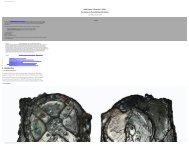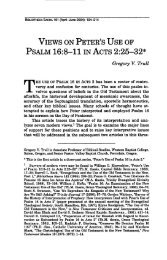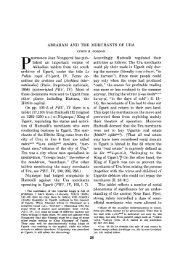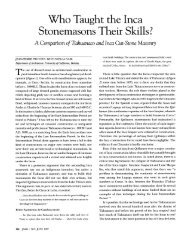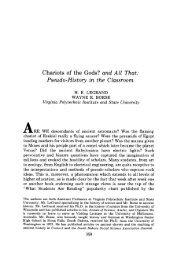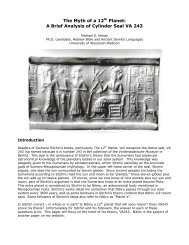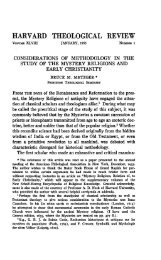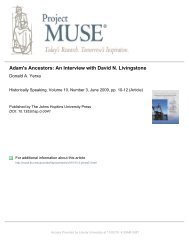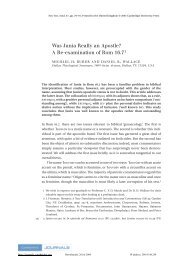Paul's Argument from Nature for the Veil in - Michael S. Heiser
Paul's Argument from Nature for the Veil in - Michael S. Heiser
Paul's Argument from Nature for the Veil in - Michael S. Heiser
You also want an ePaper? Increase the reach of your titles
YUMPU automatically turns print PDFs into web optimized ePapers that Google loves.
84 Journal of Biblical Literature<br />
<strong>the</strong> tent of meet<strong>in</strong>g or approach<strong>in</strong>g <strong>the</strong> altar, <strong>the</strong>se priests wear “l<strong>in</strong>en breeches<br />
<strong>from</strong> <strong>the</strong> lo<strong>in</strong>s to <strong>the</strong> thighs to cover <strong>the</strong>ir naked flesh” (Exod 28:42–43 RSV).<br />
Aga<strong>in</strong>, “flesh,” a euphemism, refers to <strong>the</strong> genitals (Lev 15:2, 19; Ezek 16:26;<br />
23:20). These breeches are <strong>for</strong> <strong>the</strong> glory and beauty of <strong>the</strong> priest (Exod 28:40),<br />
while exposure of <strong>the</strong> genitals subjects <strong>the</strong> priest to guilt and death (Exod<br />
28:43).<br />
In<strong>for</strong>med by this tradition, Paul appropriately <strong>in</strong>structs women <strong>in</strong> <strong>the</strong> service<br />
of God to cover <strong>the</strong>ir hair s<strong>in</strong>ce it is part of <strong>the</strong> female genitalia. Accord<strong>in</strong>g<br />
to Paul’s argument, women may pray or prophesy <strong>in</strong> public worship along with<br />
men but only when both are decently attired. 34 Even though no contemporary<br />
person would agree with <strong>the</strong> physiological conceptions <strong>in</strong><strong>for</strong>m<strong>in</strong>g Paul’s argument<br />
<strong>from</strong> nature <strong>for</strong> <strong>the</strong> veil<strong>in</strong>g of women, everyone would agree with his conclusion<br />
prohibit<strong>in</strong>g <strong>the</strong> display of genitalia <strong>in</strong> public worship. S<strong>in</strong>ce <strong>the</strong><br />
physiological conceptions of <strong>the</strong> body have changed, however, no physiological<br />
reason rema<strong>in</strong>s <strong>for</strong> cont<strong>in</strong>u<strong>in</strong>g <strong>the</strong> practice of cover<strong>in</strong>g women’s heads <strong>in</strong> public<br />
worship, and many Christian communities reasonably abandon this practice.<br />
Confus<strong>in</strong>g a testicle with a head cover<strong>in</strong>g will render even <strong>the</strong> deftest of<br />
arguments “convoluted” and prevent anyone <strong>from</strong> be<strong>in</strong>g “able to decide with<br />
certa<strong>in</strong>ty which behavior” <strong>the</strong> argument reproaches or recommends. The problem<br />
with Paul’s argument <strong>from</strong> nature <strong>for</strong> <strong>the</strong> veil<strong>in</strong>g of women <strong>in</strong> public worship<br />
arises not <strong>from</strong> Paul’s convoluted logic or flawed argumentation but <strong>from</strong><br />
<strong>the</strong> philological confusion of modern <strong>in</strong>terpreters who fail to understand <strong>the</strong><br />
ancient physiological conception of hair (kovmh) and confuse a testicle (peribovlaion)<br />
with a head cover<strong>in</strong>g. Ancient philology and physiology demonstrate<br />
that both Paul and <strong>the</strong> Cor<strong>in</strong>thians probably comprehended quite well this<br />
cogent argument <strong>from</strong> nature <strong>for</strong> <strong>the</strong> veil<strong>in</strong>g of women.<br />
34 Thus, Annie Jaubert, among o<strong>the</strong>rs, argues that <strong>the</strong> cover<strong>in</strong>g signified decency and honor<br />
ra<strong>the</strong>r than subord<strong>in</strong>ation (“Le voile des femmes [I Cor. XI.2-16],” NTS 18 [1971–72]: 425–28), but<br />
see Troels Engberg-Pedersen, “1 Cor<strong>in</strong>thians 11:16 and <strong>the</strong> Character of Paul<strong>in</strong>e Exhortation,”<br />
JBL 110 (1991): 681–82 n. 9.



